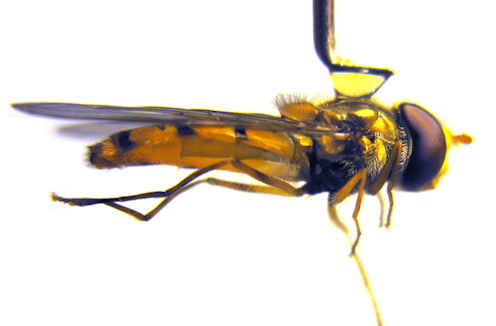
Name an animal that migrates. You might think of the long migrations of humpback whales crossing the Pacific Ocean or flocks of geese flying noisily overhead. But, did you know that huge numbers of insects make ultra-long migrations of thousands of miles almost completely unseen?
The scale is shocking: by biomass, insects outweigh the birds migrating over Britain every year eight times over. While so many eye-catching insects, from dragonflies to butterflies, migrate, it is the hoverflies that are most overlooked. Hoverflies pollinate our countryside and control garden pests as their larvae eat more than 100 aphids each.
An estimated 1 billion to 4 billion hoverflies migrate every year, unnoticed, above our skies in Britain. Special “vertical-looking” radars show that they migrate south in autumn to overwinter in southern Europe, and north again in spring. The question is, how does a 1cm-long hoverfly migrate thousands of miles?
By using a flight simulator to record the direction they fly in, my team and I discovered that they use their body clock to navigate. By changing how the hoverflies viewed the sky, we could tell that they used the sun to orientate.
With hoverflies stored under a different light cycle to shift their inner body clocks, their direction shifted. So they adjust for the position of the sun as it moves, just as Viking mariners used the sun to navigate by estimating the time of day.
Migrants not only need to travel in the correct direction, but also have incredible endurance: American hoverflies migrate 1,800 miles (3,000km). Hoverflies readily soar on any available tailwinds to boost them along, but their autumn migration pits them against the prevailing wind.
Unstable autumn weather forces them to migrate even on days with a strong headwind, so to mitigate it, they fly very close to the ground. This makes it possible for us to catch them for our surveys.
In the Port de Bucharo, a mountain pass on the border of France and Spain, insect migration is funnelled into a narrow 30m-wide corridor – perfect for catching hoverflies.
We crouched down, poised with a net, and wait for them to fly past. Insects streamed over: butterflies flitting through were easy to spot, houseflies would fly scattily, dodging from side to side. The occasional dragonfly displayed its athleticism, but we weren’t after those.
Hoverflies fly straight and direct at incredible speed. Catching them in a net was like trying to snatch bullets out of the air. We tried to attract more hoverflies with colourful objects such as a blue rain jacket or pieces of coloured felt – this worked well, especially in the mornings when inquisitive hoverflies stopped to feed.
We then used a piece of kit called a flight mill to record the distance and speed of individual hoverflies. Comparing migrating hoverflies with hoverflies caught during the summer at our campus in Penryn, Cornwall, showed that migrants flew twice as far. They also had an elevated urge to fly, this is called “migratory restlessness,” and would fly for hours on end. After their experiments they receive some tasty honey for their hard work, before being released.
We found that hoverflies with fat abdomens (a full belly) flew five times as far as thin ones, showing how important stored energy is to migration success. This is concerning as there have been big declines in migratory hoverflies, as much as 97%.
Hoverflies need to feed en-route, so could a lack of resources be the reason for their decline? The conservation outlook is complex because migratory insects should be more resilient to climate change as they can move around to wherever is best. Saving our hedgerows and leaving grass uncut is vital to provide hoverflies (and other insects) the food they need to continue their migrations for many years to come.
We were surprised that migrating hoverflies did not seem to fly faster. Birds generally move faster when they are migrating, compared to when they are foraging, as it is more energy efficient.
Bees with more intensive and energetic activity tend to live shorter lives, so hoverflies might instead throttle their speed to a sustainable pace that they can maintain over long distances. They must survive until the following spring if they are to breed, so need to end their migration in good condition.
Migrating hoverflies do not display any obvious physical differences that explain their impressive performance. Other insects grow up into special “morphs” with features such as bigger wings, despite being the same species, but we have not seen this in migrating hoverflies.
They do, however, adapt their behaviour and bodies to enable more efficient migration. By delaying their reproduction – they don’t produce eggs until it is time to breed – they save energy that they can use to fly. They also enhance their sensory genes to effectively navigate and boost their metabolism to fuel their journey.
A notable exception is muscle. It doesn’t appear as if they are packing huge biceps or a six pack. They have the physique of a long-distance runner rather than a sprinter – after all, migration is a marathon, not a sprint.

Don’t have time to read about climate change as much as you’d like?
Get a weekly roundup in your inbox instead. Every Wednesday, The Conversation’s environment editor writes Imagine, a short email that goes a little deeper into just one climate issue. Join the 40,000+ readers who’ve subscribed so far.
Richard J. Massy was supported in his work by the NERC GW4+ Doctoral Training Partnership.
This article was originally published on The Conversation. Read the original article.







